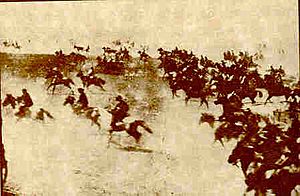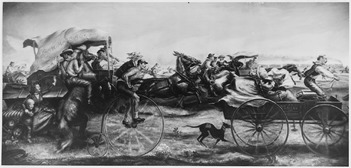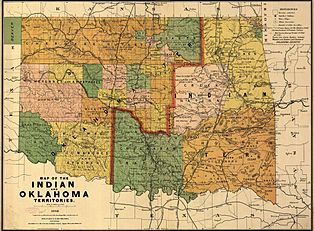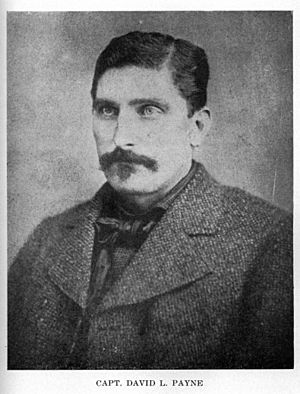Land Rush of 1889 facts for kids
The Oklahoma Land Rush of 1889 was a huge event where people rushed to claim land in what is now the state of Oklahoma. This land was once called the Unassigned Lands and was part of the Indian Territory. It had been set aside for the Creek and Seminole peoples.
The rush happened at noon on April 22, 1889. About 50,000 people were ready to grab a piece of the available 2,000,000 acres (8,100 km²).
The Unassigned Lands were seen as some of the best empty public land in the United States. President Benjamin Harrison was allowed to open these lands for settlement thanks to a new law. Before this, President Abraham Lincoln had signed the Homestead Act of 1862. This law let settlers claim up to 160 acres (0.65 km²) if they lived on the land and improved it.
Why the Land Rush Happened
During the 1800s, the U.S. government wanted to open up western lands for people to settle. They believed these lands were "idle." The Homestead Act was a law that helped this happen. To claim land, a person had to live on it for five years and farm part of it.
Most of the land that became Oklahoma was called Indian Territory. It was home to the Five Civilized Tribes: the Cherokee, Chickasaw, Choctaw, Creek, and Seminole. These tribes had been forced to move there in the 1830s from their original homes in the Southeast.
Later, a law called the Dawes Act was passed in 1887. It tried to break up the tribes' shared lands. It suggested giving 160-acre plots to families to encourage farming. This law greatly reduced the land owned by tribes. Any land left over after these distributions was called 'surplus' and sold to non-Native Americans. However, the Dawes Act didn't apply to the Five Civilized Tribes until 1902.
After the American Civil War, the Five Civilized Tribes, who had sided with the Confederacy, had to give up some of their lands. In the late 1800s, the Seminole and Creek tribes were convinced to sell about 1,900,000 acres (7,700 km²) of their land to the U.S. government. This land was then opened for settlement.
Getting Ready for the Rush
On March 2, 1889, a new law allowed the 1.9 million acres of "unassigned" lands to be opened. President Benjamin Harrison signed this bill on March 23, 1889. He announced that the land would be open on April 22, 1889. The law said that anyone who entered the land before this exact time would lose their right to claim a homestead.
The U.S. Army sent two groups of soldiers to make sure no one entered early. People who tried to settle before the official start were called "Sooners." The army cleared out all the Sooners. They also helped divide the land into 160-acre plots. These plots would be given out on a first-come, first-served basis. Land offices were set up in Kingfisher and Guthrie where people could register their claims.
Before the rush, many potential settlers camped along the edges of the Indian lands. On April 22, 1889, a huge crowd gathered. When the signal was given, thousands of people rushed across the border. About 50,000 people, young and old, men and women, raced to try and get one of the 12,000 available land plots.

A land rush in progress
|
|
| Date | April 22, 1889 |
|---|---|
| Location | Central Oklahoma |
| Also known as | Oklahoma Land Rush |
Native American Tribes and Their Lands
The forced movement of Native Americans to Indian Territory began after Andrew Jackson became president in 1828. He believed that moving Native Americans from the Southeast was necessary to allow European Americans to develop lands in states like Georgia and Alabama. President Jackson signed the Indian Removal Act on May 28, 1830.
Many tribes were forced to move, including the Choctaw, Creek, and Cherokee. The Choctaw were the first to agree to move in 1830. Many died on the long journey to the new territory. The Creek tribe also faced pressure and eventually moved by 1836. The Cherokee tribe fought to keep their lands, even winning a Supreme Court case. However, President Jackson refused to enforce the ruling. By the late 1830s, most Cherokee were forced to move, with about 4,000 dying on what became known as the Trail of Tears.
The Chickasaw tribe chose to leave their lands more freely and had better terms than other tribes. They moved in 1837–38. The Seminole Tribe was tricked into signing a removal treaty, leading to the Seminole Wars. This was a very difficult and costly war. Many Seminole were captured and sent to Indian Territory.
Other tribes were also moved to Indian Territory. These included the Quapaw, Seneca, Shawnee, Delaware, and Kickapoo. Later, the Caddo, Kiowa, Comanche, Wyandot, Cheyenne, and Wichita tribes were also relocated there.
The Boomer Movement

After the American Civil War, many Americans wanted new land in the West. People pushed their lawmakers to open the Indian Territory. From 1870 to 1879, many bills were introduced in Congress to open this land for settlement.
Railroad companies also wanted the land opened. They hired people like C. C. Carpenter to spread false news that the Indian Territory was open. Both Black and white migrants started moving to the Oklahoma Territory. President Rutherford B. Hayes warned these early settlers, known as "boomers," not to enter Indian lands. He even used the military to stop them.
Boomers and Sooners Explained
The term "Sooners" refers to people who entered the unoccupied land *before* the legal start time of the rush. They would hide and then quickly claim the best homesteads. This led to many legal arguments about what counted as the "legal time of entry."
The term "boomers" actually refers to those who actively campaigned and pushed for the lands to be opened for settlement. A famous leader of the Boomer movement was David L. Payne.
The University of Oklahoma's fight song, "Boomer Sooner," and their mascots, "Boomer" and "Sooner," come from these historical names.
David Payne's Role
Captain David L. Payne was a key leader in the movement to settle Oklahoma Territory. He and others created the Oklahoma Colony. Settlers could join for a small fee. Once in Oklahoma, they formed a company that sold land plots. Cattle ranchers, worried about losing their land, worked with the military to keep the boomers out. The military often arrested boomers who entered unlawfully, but they were usually released without trial.
David Payne died in 1884. Some people think he was poisoned by cattlemen who were unhappy with his success.
William Couch's Leadership
William Couch took over from Payne. He studied all the laws and treaties about the Oklahoma land issue. He led some unsuccessful attempts to enter Indian Territory. The movement slowed down but restarted when the Santa Fe Railroad built a line through the middle of Indian Territory.
Couch and other delegates went to Washington to push for a law to open the lands. They faced opposition from people who argued that the U.S. government had promised the land to the Native American Nations living there.
Eventually, the Indian Appropriation Bill was passed. This bill paid the Seminole and Creek Nations for their land. It also gave the president the power to open the land for settlement.
African-Americans and the Land Rush
African Americans were looking for places where they could build communities free from racism. Many saw the Land Rush as a chance to create their own towns and culture. Some hoped to make Oklahoma a state just for Black families.
An organization called the Oklahoma Immigration Organization, led by W. L. Eagleson, spread the word about this opportunity, especially in the South. There was even a plan to make Edward P. McCabe the governor of Oklahoma Territory to help Black families settle there. This plan didn't work out, but many Black families still moved to the territory and formed new towns, like parts of Kingfisher.
The Rush for Land Begins
On April 22, 1889, at noon, President Benjamin Harrison declared the Unassigned Land open. When the signal gunshot fired, thousands of people on horses and in wagons rushed forward in a cloud of dust. The chase for land was wild and chaotic.
The rush didn't last long. By the end of that day, almost two million acres of land had been claimed. By the end of the year, 62,000 settlers lived in these new lands.
Fast Growth of New Towns
By the end of April 22, 1889, both Oklahoma City and Guthrie had grown into cities of about 10,000 people each. As a newspaper reported:
At twelve o'clock on Monday, April 22d, the resident population of Guthrie was nothing; before sundown it was at least ten thousand. In that time streets had been laid out, town lots staked off, and steps taken toward the formation of a municipal government.
Many settlers immediately started improving their new land or waited in long lines to file their claims. Children sold creek water to settlers waiting in line. Within a month, Oklahoma City had five banks and six newspapers!
On May 2, 1890, the Oklahoma Organic Act was passed. This law created the Oklahoma Territory and included the Oklahoma Panhandle. It also set up a central government and made Guthrie the capital of the territory.
How Cities Expanded
When the signal was given, over a dozen trains pulled into Oklahoma Territory. But most people traveled on horseback, in wagons, or on foot. To claim land, a settler had to place a stake with their name on it at a U.S. land office, like those in Guthrie or Kingfisher.
The settler then had to live on the land for five years and clearly improve it, for example, by building on it. After that, they could officially own the property. This five-year period could be shortened to fourteen months if the settler paid $1.25 per acre.
Six towns were established in 1889: Guthrie, Oklahoma City, Kingfisher, El Reno, Norman, and Stillwater. These were chosen as county seats. Guthrie was the first capital of the Territory. Oklahoma City later became the permanent capital of the state.
The Land Rush in Popular Culture
The Oklahoma Land Rush of 1889 has been shown in movies and other media:
- Two movies named Cimarron (from 1931 and 1960) were based on a novel by Edna Ferber. They show pioneer life during the land rush.
- The Oklahoma City 89ers was the original name for Oklahoma City's minor league baseball team from 1962 to 1997. The "89ers" name came from the 1889 Land Rush. The team is now called the Oklahoma City Dodgers.
- The movie Far and Away (1992), starring Tom Cruise and Nicole Kidman, shows a young Irish couple who come to America hoping to take part in the Oklahoma Land Run.
- The Rush is a main theme in the comic album Ruée sur l'Oklahoma, which is the 14th album of the Belgian comic series Lucky Luke.
Images for kids




